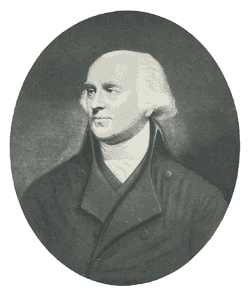Robert Barker, Painter of Panoramas
(b. 1739, d. 1806)
Painter of Panoramas
From A Dictionary of Irish Artists 1913

Robert Barker. Mezzotint by J. Flight.
Was born at Kells, County Meath, in 1739. According to Redgrave he set up in business in Dublin, and failing in this tried portrait and miniature painting. Nothing is known of his work as an artist in Dublin, but he was apparently not successful and leaving Ireland he settled in Edinburgh, where for some time he practised as a portrait and miniature painter. He possessed much inventive talent and devised a mechanical system of perspective which he taught. The view from Calton Hill first suggested the idea of a panorama; and in 1787, assisted by his son Henry then about twelve years of age, he made drawings of a half-circle view from the hill, and after surmounting many difficulties completed his picture in water-colour and took it to London.
Sir Joshua Reynolds, to whom he showed his drawings, thought the scheme impracticable, but Barker persevered in his design and completed a whole-circle view of Edinburgh twenty-five feet in diameter. This he exhibited in the Archer's Hall at Holyrood and afterwards in the Assembly Rooms in George Street. In 1788 he exhibited his view in London, in a large room in the Haymarket. He next made a panorama of "the Thames, with the Lord Mayor's procession from Westminster on the 9th November," from drawings made by his son Henry from the top of the Albion Mills, near the foot of Blackfriar's Bridge. This view, painted in distemper, was exhibited in 1792, and encouraged by his success Barker erected in Leicester Place, Cranbourne Street, a large building where his panoramic views were afterwards exhibited. It was opened in 1794 with the panorama of "Portsmouth and the Fleet at Spithead." This, as well as his subsequent works, was painted in oil. The success of his invention was complete, and each year added to the popularity of his panoramas.
In his building in Leicester Place he exhibited in succession views of Brighton, Windsor, Margate, Malta, Gibraltar and Paris. He died in his house in West Square, Southwark, on 8th April, 1806, aged 67.
Barker married a daughter of Dr. Aston of Dublin, and by her had two sons. The elder son, THOMAS EDWARD BARKER, worked with his father and in 1802 entered into partnership with Ramsay Richard Reinagle, who had also worked with Robert Barker, and started a rival panorama in the Strand. The second son, HENRY ASTON BARKER, trained as an artist by his father, and also in the schools of the Royal Academy, was born in Glasgow in 1774. He assisted his father in his panoramas, making most of the drawings for them. Those for the Thames panorama he reproduced and published in six sheets, about twenty-two inches by seventeen inches, in 1792 and 1793. They were etched by himself and aquatinted by F. Birnie. After his father's death he continued to carry on the undertaking and produced a number of panoramas. In 1826, having realized a handsome competency, he retired. He died at Bilton, near Bristol, on 19th July, 1856, aged 82.
A portrait of Robert Barker was painted by C. Allingham and engraved in mezzotint by J. Flight. Another portrait, after J. Ralph, was engraved by J. Singleton in 1802. A good account of Robert Barker and H. A. Barker and their panoramas will be found in the "Art Journal" for 1857, page 46.
